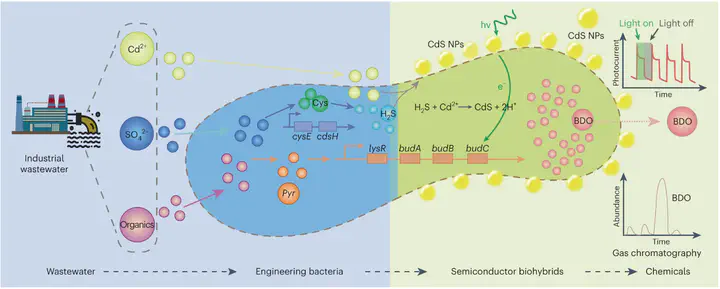Solar-Driven Waste-to-Chemical Conversion by Wastewater-Derived Semiconductor Biohybrids
Nature Sustainability 2023

Abstract
Semiconductor biohybrids integrating the merits of living cells and semiconductor materials have the potential to shift the current energy-intensive chemical production system to a more sustainable one by offering efficient solar-to-chemical conversion. However, cost-competitive and environmentally friendly scaling-up approaches are still urgently needed. To tackle this challenge, we propose a strategy that co-utilizes pollutants in wastewater to produce semiconductor biohybrids in-situ for scalable solar-to-chemical conversion. Specifically, we introduce an aerobic sulfate reduction pathway into Vibrio natriegens to enable the direct utilization of heavy metal ions (that is, Cd2+), sulfate and organics in wastewater to biosynthesize functional semiconductor nanoparticles in living V. natriegens to assemble semiconductor biohybrids. Meanwhile, a designated biosynthetic pathway is introduced into the biohybrids to enable the production of 2,3-butanediol, a valuable bulk chemical with wide applications, from organics in wastewater. Using the obtained biohybrids, the production of 2,3-butanediol reaches 13.09 g l−1 in a 5-l illuminated fermenter using wastewater as the feedstock, revealing its scalability. Life-cycle assessment shows that this specific biohybrid route has substantial sustainability gain compared with conventional 2,3-butanediol production routes. This work can bring solar-driven biomanufacturing and waste-to-wealth conversion one step forward and pave the way to cleaner production and circular economy.